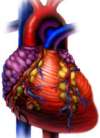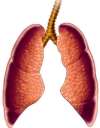
CPR Definition
Cardio = HEART
Pulmonary = LUNGS
Resuscitate = REVIVE
Cardio-Pulmonary Resuscitation = Reviving the Heart and Lungs

Cardio = HEART
Your heart is a big, strong muscle that expands and contracts more than 60 times a minute without you even thinking about it. It is automatically driven by electrical impulses and runs 24 hours a day, 7 days a week, with no vacation time. That's around 33 million beats a year!
Your heart has a simple, but important job. It pumps oxygen-rich blood from the lungs out to the rest of your body. If your heart stops pumping, oxygen does not reach vital organs and they stop working. That's when you get in trouble.

Pulmonary = LUNGS
You breathe about 10 to 15 times each minute and every breath you take brings oxygen into your lungs and gets rid of carbon dioxide. Your lungs function automatically just like your heart - you don't have to think about breathing, it just happens.
Oxygen is important to your body because it gets combined with sugar to burn as fuel. There is very little oxygen stored in your body's tissues so it needs to be replenished often. (There is a big supply of sugar so you can go a long time without eating.)
If your body stops bringing air with oxygen in it into your lungs or your heart stops circulating the oxygen-rich blood to your organs, then bad things start to have real fast. When the oxygen runs out, the body only has a few minutes in an anaerobic state before cells start to die and brain damage results.
Typically, cells last 4 to 6 minutes before they begin to die and, after 10 minutes, the body is usually unrevivable.
Some things that might prevent oxygen from reaching the cells of your body:
Choking
- something blocks the path for air to reach the lungs.Poisoning
- some other gas takes the place of oxygen, such as carbon monoxide.Drowning or suffocation
- there is no air available to breathe in.Electric shock
- an electric impulse disrupts the normal heart pattern and causes it to stop.Heart attack
- the heart stops beating. Oxygen is available in the blood in the lungs, but the heart is not moving it around.Ventricular Fibrillation (VF)
- the heart gets out of synch and quivers instead of pumps, causing cardiac arrest. This is the most common cause of cardiac arrest and is what Automated External Defibrillators (AEDs) are for.
CardioPulmonary Resuscitation (CPR)
is a combination of simulating the breathing of the lungs and the pumping of the heart. You should know that CPR is effective less than 30% of the time. Does that mean it is futile? No way! The types of victims you will probably run into will most likely be on the high end of the probability scale. Recovery rates for people already in the hospital are about half that and less than 5% for elderly people with other medical problems. So, even though there's a good chance your efforts will fail, that person has a 0% chance if you do nothing. Let's talk about what CPR is and how it works.CPR is made up of two parts: Rescue Breathing and Chest Compresssions
Rescue Breathing
You exhale air from your lungs into the victim's lungs so they can absorb oxygen. This assumes that there is adequate oxygen in your exhaled air.Air contains approximately 20% oxygen at sea level, 16% at 5000 feet elevation, and 13% at 10000 feet. When we breathe in air, our lungs absorb about 25% of whatever is available. So, at sea level, we exhale air with about 15% oxygen which is more than exists at 5000 feet and is adequate.
When you breathe into a victim's mouth and have their nose closed, the air is forced into their lungs and you can see the chest rise. You have successfully gotten some amount of oxygen into the system.
Chest Compressions
You manually compress the heart by pressing down on the chest. When you let up on the chest, the heart expands. The hope is that by compressing and expanding the heart, the blood flows through it as designed. Unfortunately, you don't have an easy way to tell if blood is flowing. You can't feel for a pulse or see results. You just need to believe in your efforts.
CPR Effectiveness
When properly performed, CPR simulates from 20 to 40% of normal circulation. That is not enough to sustain life indefinitely, but will be sufficient to put off the start of cell death in the hope that revival tools arrive soon. You should not expect CPR to restart a heart and have the victim pop back to life like is shown on TV. Your job is to keep oxygenated blood flowing until life support services arrive.
In communities with a thorough CPR training program and fast access to ACLS through an efficient Emergency Medical Services program, CPR can be effective up to half the time. Other places where CPR training is not promoted or where little ACLS support is available, the results are much less. Remember, your goal of administering CPR is to buy a little time for an emergency rescue team to arrive and revive.
So, what does CPR stand for? It stands for saving a life.

Next: CPR Skills

